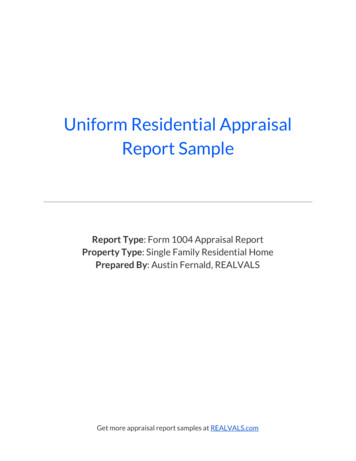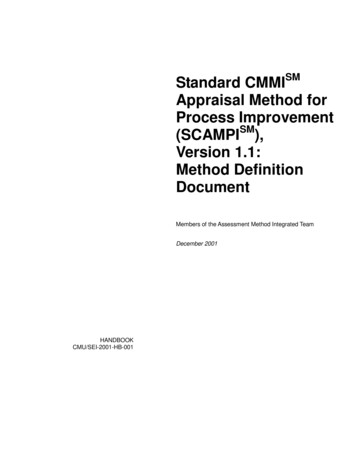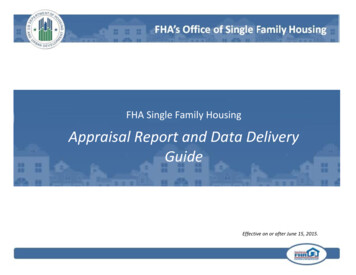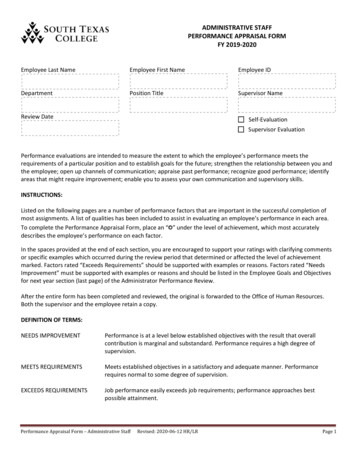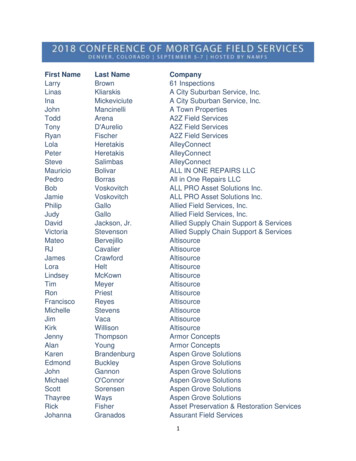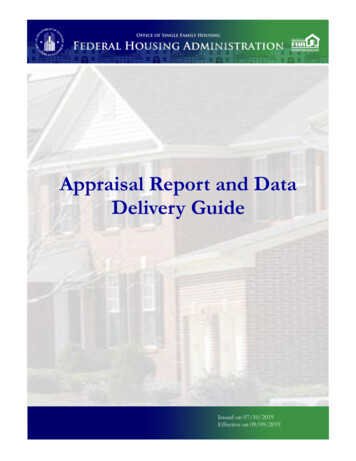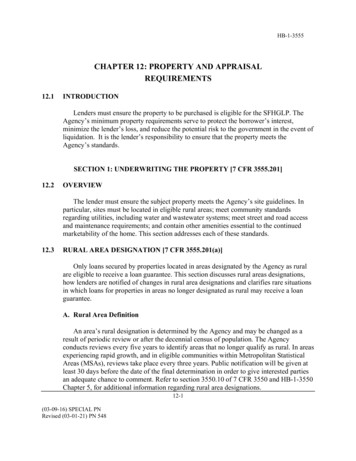
Transcription
HB-1-3555CHAPTER 12: PROPERTY AND APPRAISALREQUIREMENTS12.1INTRODUCTIONLenders must ensure the property to be purchased is eligible for the SFHGLP. TheAgency’s minimum property requirements serve to protect the borrower’s interest,minimize the lender’s loss, and reduce the potential risk to the government in the event ofliquidation. It is the lender’s responsibility to ensure that the property meets theAgency’s standards.SECTION 1: UNDERWRITING THE PROPERTY [7 CFR 3555.201]12.2OVERVIEWThe lender must ensure the subject property meets the Agency’s site guidelines. Inparticular, sites must be located in eligible rural areas; meet community standardsregarding utilities, including water and wastewater systems; meet street and road accessand maintenance requirements; and contain other amenities essential to the continuedmarketability of the home. This section addresses each of these standards.12.3RURAL AREA DESIGNATION [7 CFR 3555.201(a)]Only loans secured by properties located in areas designated by the Agency as ruralare eligible to receive a loan guarantee. This section discusses rural areas designations,how lenders are notified of changes in rural area designations and clarifies rare situationsin which loans for properties in areas no longer designated as rural may receive a loanguarantee.A. Rural Area DefinitionAn area’s rural designation is determined by the Agency and may be changed as aresult of periodic review or after the decennial census of population. The Agencyconducts reviews every five years to identify areas that no longer qualify as rural. In areasexperiencing rapid growth, and in eligible communities within Metropolitan StatisticalAreas (MSAs), reviews take place every three years. Public notification will be given atleast 30 days before the date of the final determination in order to give interested partiesan adequate chance to comment. Refer to section 3550.10 of 7 CFR 3550 and HB-1-3550Chapter 5, for additional information regarding rural area designations.12-1(03-09-16) SPECIAL PNRevised (03-01-21) PN 548
HB-1-3555In general, rural areas are defined as: Open country that is not part of, or associated with, an urban area; Any town, village, city, or place, including the immediately adjacent denselysettled area, which is not part of, or associated with, an urban area, and which:o Is rural in character with a population of less than 10,000; oro Is not contained within an MSA and has a population above 10,000 but below20,000 and has a serious lack of mortgage credit for lower and moderateincome families. Any area classified as “rural” or a “rural area” prior toOctober 1, 1990, and determined not to be “rural” or a “rural area” as a resultof data received from or after the 1990, 2000, or 2010 decennial census, andany area deemed to be a “rural area” any time during the period beginningJanuary 1, 2000, and ending December 31, 2010, shall continue to be soclassified until the receipt of data from the decennial census in the year 2020if such area has a population in excess of 10,000 but not in excess of 35,000,is rural in character, and has a serious lack of mortgage credit for lower andmoderate-income families. Two or more towns, villages, cities, or places that are contiguous may beconsidered separately for a rural designation if they are not otherwise associatedwith each other, and their densely settled areas are not contiguous.B. Notification of Rural Area DesignationThe public website noted below provides an automated system to allow users to enteraddresses and determine property eligibility. Users who utilize the public website willreceive one of three property eligibility decisions when an actual address is entered –“Eligible,” “Ineligible,” or “Unable to Determine.” In areas not clearly delineated, userswill receive an “Unable to Determine.” With this type of determination, the lender mustconfirm with Agency staff the property is located in a rural area and eligible for aguarantee prior to requesting an appraisal.USDA Rural Development Property and Income Eligibility ment 12-A of this Chapter provides guidance on utilizing the public website todetermine eligible rural areas.12-2
HB-1-3555C. Making Loans in Areas Changed to Non-ruralIf an area’s designation changes from rural to non-rural, loans that meet the followingcriteria may be approved in that area: Purchase transactions are eligible if the following requirements are met:o The application is dated and received by the lender prior to the areadesignation change;o The Loan Estimate was issued within three days of the application date;o The purchase contract is ratified prior to the date of the area designationchange; ando The applicant and property meet all other loan eligibility requirements.12.4 Existing conditional commitments that have been issued will be honored providedthe commitment was issued prior to the area designation change; Existing direct and guaranteed loans that meet all requirements, as outlined inChapter 12, remain eligible for refinance transactions; REO property sold from Agency inventory remain eligible for purchasetransactions; SFHGLP REO property sales and transfers with assumption may be processed inareas that have changed to non-rural; A supplemental loan may be made in conjunction with a transfer and assumptionof a guaranteed loan.SITE REQUIREMENTS [7 CFR 3555.201(b)]A qualified property must be predominately residential in use, character, and design.Sites must be developed in accordance with any standards imposed by a State or localgovernment. Therefore, the lender must verify that the following requirements are met atthe time of application.12-3(03-09-16) SPECIAL PNRevised (03-01-21) PN 548
HB-1-3555 Site size. There is no specific limitation to the size/acreage of the site. Theappraiser must provide an explanation in the addendum of the appraisal to explainadjustments to comparable properties, how the subject compares to otherproperties in the area, etc. Income-Producing Buildings. The property must not include buildingsprincipally used for income-producing purposes. Barns, silos, commercialgreenhouses, or livestock facilities used primarily for the production ofagricultural, farming or commercial enterprise are ineligible. However, barns,silos, livestock facilities or greenhouses no longer in use for a commercialoperation, which will be used for storage do not render the property ineligible.Outbuildings such as storage sheds and non-commercial workshops are permittedif they are not used primarily for an income producing agricultural, farming orcommercial enterprise. A minimal income-producing activity, such as maintaininga garden that generates a small amount of additional income, does not violate thisrequirement. Home-based operations such as childcare, product sales, or craftproduction that do not require specific commercial real estate features are notrestricted. Accessory Dwelling Unit. The presence of an accessory dwelling unit (ADU)does not automatically render the property ineligible. The appraiser willdetermine if the ADU represents a second single family housing dwelling unit.The Agency defers to the appraiser’s professional review of the property andexpert opinion of the highest and best use of the subject property as a primaryresidence. The appraiser will include their evaluation in the site analysis sectionof the appraisal report if applicable. Income-Producing Land. The site must not have income-producing land thatwill be used principally for income producing purposes. Vacant land or propertiesused primarily for agricultural, farming or commercial enterprise are ineligible. Multiple Parcels. The lender will ensure the mortgage provides a valid first liencovering each parcel. Each parcel must be conveyed in its entirety and have thesame zoning. Parcels must be contiguous unless divided by a road and theremaining parcel cannot be developed i.e. waterfront properties where the parcelwithout the residence provides access to the water. The entire property willcontain only one dwelling but can have non-residential, non-income producingbuildings such as a garage.12-4
HB-1-3555 Properties with Solar Panels. Dwellings with solar panels are not considered anincome producing property. If the property owner (seller) is the owner of the solarpanels and the solar panels will be included as part of the purchase transactionthen standard eligibility requirements apply, i.e. appraisal, insurance, and title. Ifthe solar panels are subject to a lease agreement, power purchase agreement(PPA), or similar type of agreement the following requirements apply:o Leases and contracts will vary by company and should be considered on acase by case basis to ensure all terms/regulations are met.o First lien position, by the lender, should be protected and maintained.o The property should maintain access to an alternative source of electric/gaspower that meets community standards.o The energy company or lessee should not block any foreclosure or servicingactions.o If an agreement for an energy system lease or PPA could cause restrictionupon transfer of the house, the property is subject to impermissible legalrestrictions and is generally ineligible for the guaranteed loan.o The lease agreement or PPA should indicate that any damage that occurs as aresult of installation, malfunction, manufacturing defect, or the removal of thesolar panels is the responsibility of the owner of the equipment and the owneris obligated to repair the damage and return the improvements to their originalor prior condition.o The lease agreement, PPA, or other agreement should indicate that the ownerof the solar panels cannot be a loss payee on the homeowner’s insurancepolicy.o If a lease includes payment for equipment it should be considered a debt andincluded in the total debt ratio. See Chapter 11 for additional guidance.o Leased solar panels are considered personal property and are not included inthe appraised value.o Properties with Property Assessed Clean Energy (PACE) loans or assessmentsare ineligible for a SFHGLP loan.12-5(03-09-16) SPECIAL PNRevised (03-01-21) PN 548
HB-1-3555 Site Specifications. The site must be contiguous to, and have direct access from astreet, road, or driveway. Streets and roads must be hard surfaced, or all weathersurfaced, with public access or permanent recorded easements. Utilities. The site must be supported by adequate utilities and water andwastewater disposal systems. Zoning. The property must comply with applicable zoning and restrictions. If anexisting property does not comply with all current zoning ordinances but it isaccepted by the local zoning authority, the appraiser must report the property aslegal non-conforming. The appraisal must reflect any adverse effect of the legalnonconforming use on the value and marketability of the property.SECTION 2: APPRAISALS [7 CFR 3555.107(d)]12.5RESIDENTIAL APPRAISAL REPORTSApproved lenders must ensure appraisals are completed by a qualified appraiser thatis independent and objective. Approved lenders are responsible to review all appraisalsfor integrity, accuracy, and thoroughness, prior to submission of a complete loanapplication package to USDA. The lender may pass the cost of the appraisal on to theborrower. The appraisal must have been completed within 150 days of loan closing.Appraisals that are older than 150 days prior to loan closing are eligible for an appraisalupdate as indicated in this Chapter.A. Qualified Appraiser.Approved lenders must select qualified and competent appraisers that are properlylicensed or certified, as appropriate, in the State in which the property is located. Theappraiser must comply with the current edition of the Uniform Standards of ProfessionalAppraisal Practice (USPAP). Lenders may verify that an appraiser is licensed or certifiedby checking the Appraisal Subcommittee website found at:https://www.asc.gov/Home.aspx.B. Appraisal Report.All appraisals must comply with the reporting requirements of USPAP available atwww.appraisalfoundation.org. All appraisal reports must meet the Uniform AppraisalDataset (UAD) requirements set forth by Fannie Mae and Freddie Mac. To readdefinitions of condition and quality ratings, refer to the “Fannie Mae and Freddie Mac12-6
HB-1-3555Uniform Appraisal Dataset Specification Version 1.2” located online at:https://www.fanniemae.com/content/technology requirements/uad-specificationappendix-d.pdfThe appraiser will determine the appropriate appraisal form for the subject property.Appraisers must utilize appraisal forms acceptable to Fannie Mae, Freddie Mac, HUD, orVA. Applicable forms may include: Uniform Residential Appraisal Report (FNMA Form 1004/FHLMC Form 70) forone-unit single family dwellings; Manufactured Home Appraisal Report and addendum (FNMA Form1004C/FHLMC Form 70B) for all manufactured homes; Individual Condominium Unit Appraisal Report (FNMA Form 1073/FHLMCForm 465) for all individual condominium units.Appraisal considerations: Appraiser/client confidentiality under USPAP Ethics Rules does not permit theappraiser to discuss the appraisal with anyone other than the client, without theclient’s permission. It is recommended, but not required, that USDA/RD beidentified as an intended user with the lender in the appraisal report obtained. The market or sales comparison approach is required in all cases. Not less thanthree comparable sales will be used unless the appraiser provides documentationthat such comparable sales are not available. The appraiser must use theirknowledge of the area and apply good judgment in the selection of comparablesales that are the best indicators of value for the subject property. The appraiser will determine if the cost approach is required. For example, theproperty is unique, or has specialized improvements, or is new manufacturedhousing, or if the client requests the cost approach to be completed, then theappraiser will identify the source of the cost estimates and will comment on themethodology used to estimate depreciation, effective age and remaining economiclife. The income approach is only required if the appraiser determines that it isnecessary to develop credible assignment results.12-7(03-09-16) SPECIAL PNRevised (03-01-21) PN 548
HB-1-3555 An appraisal prepared for REO purposes, loan servicing consideration, or anyother purpose other than the guaranteed purchase or refinance transaction isineligible to be used in the origination of a guaranteed loan. A new appraisal withthe intent to arrive at an opinion of value for a purchase transaction must beobtained.Photographs. Photographs in the appraisal report must be in color and be clear anddescriptive to identify the property’s condition and quality. Photographs must clearlyrepresent the improvements, any physical deterioration of the property, amenities,conditions and external influences that may have a material effect on the market value ormarketability of the subject property. Lenders who utilize the Agency’s automatedunderwriting system, GUS, will upload the appraisal report at the Application Documentspage, by selecting 10002 Appraisal Report and uploading as an individual document. Anappraisal report with interior and exterior inspection of the subject property must includeat least the following: A front view of the subject property; A rear view of the subject property; A street scene identifying the location of the subject property and showingneighboring improvements; The kitchen, main living area, bathrooms, bedrooms; Any other rooms representing overall condition, recent updates, such asrestoration, remodeling and renovation; Basement, attic and crawl space; Comparable sales, listings, and/or pending sales utilized in the valuation analysismust include at least a front view of each comparable utilized; and Condominium projects should include additional photographs of the commonareas and shared amenities.Appraisal transfer. An appraisal ordered by another lender for the applicant can betransferred to the lender who will complete the purchase transaction. The initial lendermust agree to the transfer of the report. A letter from the initial lender who ordered theappraisal report must be retained in the permanent loan file as evidence the lendertransferred the report to the lender completing the purchase transaction. The receivinglender must assume full responsibility for the integrity, accuracy and thoroughness of the12-8
HB-1-3555appraisal report, including the methods that the original lender used to acquire theappraisal. The appraisal report must be no older than 150 days at loan closing to be valid.Appraisal update. The validity period of an appraisal report can be extended onlyone time with an Appraisal Update Report. The appraisal may be expired at the time theappraisal update is requested. However, when the original appraisal is subsequentlyupdated, the appraisal is valid for no greater than 240 days from the effective date of theoriginal appraisal report at loan closing. The purpose of an appraisal update request is todetermine if the property has declined in value since the effective date of the originalappraisal. An update is not eligible to support a higher appraised value of the property.USPAP considers the term “Appraisal Update” as a business term, but regardless ofthe nomenclature used, when a client seeks a more current value or analysis of a propertythat was the subject of a prior assignment, this is not an extension of that priorassignment that was already completed; it is simply a new assignment. Refer to USPAPAdvisory Opinion 3 for additional clarification available atwww.appraisalfoundation.org.USPAP (Advisory Opinion 3) states that there are three ways that the reportingrequirements can be satisfied for this type of assignment:1. Provide a new report without incorporation of the prior report.2. Provide a new report that incorporates by attachment specifiedinformation/analysis from the prior report.3. Provide a new report that incorporates by reference specified information/analysisfrom the prior report.The appraiser may use a pre-printed form or a narrative report to provide the appraisalupdate, but whichever reporting format is used, it must be in compliance with USPAP.Fannie Mae Form 1004D/Freddie Mac Form 442, “Appraisal Update and/orCompletion Report” may be utilized by the lender to report the completion of a repairand/or satisfaction of requirements and conditions noted in the original appraisal report.Property flipping. It remains the lenders responsibility to ensure any recently soldproperty’s value is strongly supported when a significant increase between sales occur.The lender must perform a thorough review of the appraisal report to validate and supportthe property’s value and protect the applicants from possible predatory real estatelending.12-9(03-09-16) SPECIAL PNRevised (03-01-21) PN 548
HB-1-3555C. Agency Review.The Agency will review appraisals for all guarantee loan requests by completingForm RD 1922-15, “Administrative Appraisal Review.” If the Agency reviewer detectsconcerns, the appraisal will be referred to a Regional Agency Appraiser for a technicaldesk or technical field review. Should the Agency licensed appraisers determine theappraisal is not adequate the lender will be informed of corrections needed prior toissuance of the conditional commitment for loan guarantee. The lender will be required tocorrect or complete any appraisal returned by the Agency for corrective action. Thelender is responsible to communicate and initiate corrective action with the appraiser.The corrected appraisal will be subject to the same review process described in thissection. The Agency retains the right to determine an appraiser is ineligible based upontheir failure to comply with requirements of this section. The Agency will notify thelender when appraisals completed by ineligible appraisers will no longer be accepted forthe SFHGLP.D. Director of the Origination and Processing Division Responsibilities.The Director OPD will designate or delegate authority to the supervisory staff of theunit or other qualified personnel to conduct administrative appraisal reviews. Technicalappraisal reviews must be completed by an Agency certified or licensed appraiser andneed only be licensed or certified in one State or territory to perform real estate appraisalduties as Federal employees in all states and territories. Review appraisers must haverecent, documented appraisal experience or other factors which clearly establish theirqualifications as a reviewer.The Director OPD will determine and establish the training needs for RuralDevelopment staff completing appraisal reviews. The Director OPD will also assure thatan adequate amount of reviews are being completed.E. Types of Agency Reviews.There are three types of reviews for appraisals; "Administrative," "Technical Desk"and "Technical Field." An administrative review will be completed for all transactionsinvolving the submittal of an appraisal report. A sufficient number of technical desk andtechnical field reviews will be completed to ensure the Agency is getting qualityappraisals for the Guaranteed Loan Program. An explanation of the review types are asfollows:12-10
HB-1-35551. Administrative ReviewsAdministrative reviews are performed by the Agency loan approval official orqualified designee on all appraisals prior to issuance of the Conditional Commitment.This review determines if there are inconsistencies in the appraisal report that mayhave to be addressed, or if a technical review should be completed by the Agencystaff appraiser prior to issuance of the Loan Note Guarantee. Indicators that atechnical review may be required will be documented on Form RD 1922-15. Administrative reviews are completed by the Agency on Form RD 1922-15.This form will be signed, dated, and retained in the Agency file for scanning.This review should be completed prior to issuance of the ConditionalCommitment; If there is a deficiency with an appraisal, the loan approval official shouldcommunicate the deficiency to the lender. These deficiencies should includeitems that affect loan security, value conclusions, or unacceptable propertyconditions.2. Technical Desk ReviewsA technical review is performed to determine whether the appraisal was complete,was clearly reasoned, and had adequate support for the conclusion of value. Technicalreviews are performed by the Agency Appraiser. Technical reviews completed byAgency appraisers must follow current USPAP. Technical desk reviews may be documented in any format that complies withUSPAP and is acceptable for use by RD. Technical reviews should be selectedin a random method. The percent of files randomly selected will be set by thedirection of the SFHGLD. Field offices will be advised of these schedules andany changes.The Director OPD or designated supervisory staff will coordinate with ProgramSupport Staff (PSS) in National Headquarters to establish internal managementcontrols and systems to document and substantiate residential appraisal complianceactivities, which will be evaluated during State Internal Reviews, Single FamilyHousing program reviews, or Management Control Reviews. Technical desk reviewof appraisals received by the agency provide a method of internal control by theappraisal review staff and ensure that appraisals received by the agency are incompliance with USPAP and Agency regulations. The Director OPD or designatedsupervisory staff will support completion of technical desk reviews in coordinationwith PSS to achieve the appraisal quality control requirements of the agency.12-11(03-09-16) SPECIAL PNRevised (03-01-21) PN 548
HB-1-3555A technical review may also be requested by OPD staff when problems aredetected on the administrative review that cannot or will not be addressed by thesubmitting lender or original appraiser. These problems must be significant andresult in an appraisal which does not support the value conclusion. OPD staff willdocument the nature of their concerns on Form RD 1922-15. The appraisal will thenbe forwarded to the Appraisal Services Branch for a technical and/or field reviewprior to approval of the loan.3. Technical Field ReviewsField reviews will involve on-site visits to the subject property and thecomparable properties used in the report. Field reviews are completed by AgencyAppraisal staff on a random, spot-check basis to determine if the appraiser hasfollowed accepted appraisal techniques and arrived at a logical conclusion. USPAP Standard 3 Review is used for technical field reviews. The reviewermay use any reporting format that complies with USPAP and is acceptable foruse by RD. The Director OPD or designated supervisory staff and theappraisal review staff are responsible for the administration of residentialappraisal compliance and training within the geographic jurisdiction of theState Office. Appropriate actions will be initiated by the Director OPD ordesignated supervisory staff and appraisal review staff to ensure compliancewith USPAP and National Office policies governing the residential appraisalprocess.F. Appraisals in Remote Rural Areas, on Tribal Lands, or in Areas LackingMarket Activity.In remote, rural areas, on Tribal lands, or areas with a lack of market activity, asidentified by the Director OPD, it may be difficult to obtain adequate comparable sales toappraise a property. When the sales comparison approach cannot be developed for acredible opinion or conclusions regarding value, the lender’s appraiser may use othermethods in compliance with the Uniform Standards of Professional Appraisal Practice(USPAP) and perform an appraisal without completing the sales comparison approach tovalue. Appraisers must explain the exclusion of the sales comparison approach to valueand document their efforts to obtain comparable market data along with an explanationfor any sales data not used. The primary method that the appraiser is relying on shouldbe summarized to the extent that the user or a review appraiser can understand thereasoning and support of the valuation and conclusions.12-12
HB-1-3555Remote rural areas are identified by the Director OPD and are defined as areas withall the following characteristics: Scattered population; Low density of residences; Lack of basic shopping facilities; Lack of community and public services and facilities; and Lack of comparable sales data.If the appraiser is using the cost approach, external depreciation based on theremoteness of the site must not be considered; however, factors that impact the site suchas immediate proximity to a feedlot, factory, or other similar considerations should beincluded. If the appraiser is using the income approach, they must explain why theincome and expenses used are comparable to the subject property. When a market isestablished in these areas, the Agency will again require the sales comparison approach tobe used.12.6WATER AND WASTEWATER DISPOSAL SYSTEMS [7 CFR 3555.201]The site must have acceptable water and wastewater disposal systems to ensure theproperty is decent, safe, sanitary, and meets community standards. Public water andwastewater disposal systems are presumed to meet state and local requirements with noadditional documentation or inspections. Private well and wastewater systems that meetthe requirements in HUD Handbook 4000.1 or meet the requirements of local and/or statehealth authority do not require additional inspections other than water purity tests asdiscussed in this section. Evidence will be retained in the lender’s permanent loan file.A. WaterWater systems, for existing or new construction, that require continuous or repetitivetreatment to be safe bacterially or chemically may be used if the individual water system,with purification, meets the requirements of the state department of health or othercomparable reviewing and regulatory authority.12-13(03-09-16) SPECIAL PNRevised (03-01-21) PN 548
HB-1-35551. Individual Privately Owned Individual water systems are owned and maintained by the homeowner andsubject to compliance with all requirements of the local and/or State HealthAuthority codes. Water quality tests are required as follows:o The water quality of the well must meet the requirements of the state orlocal authority. If the state or local authority does not have specificrequirements, the maximum contaminant levels established by theEnvironmental Protection Agency (EPA) will apply.o The local health authority or a state certified laboratory must perform awater quality analysis. The Safe Water Drinking Act does not apply toprivate wells. Contact the Environmental Protection Agency (EPA) at(800) 426- 4791 for referral to certified labs and other inquiries.o The water analysis report must be no greater than 150 days old at loanclosing. If the Agency is aware of any recent environmental impacts thatmay render the previous analysis invalid (for example – chemical spills,natural disasters, etc.) a new report may be required. The well location for individual water supply systems must be measured toestablish the distance from the septic system. The separation distance betweenthe well and septic systems must meet the SF Handbook (HUD Handbook4000.1) or be found acceptable by the Local and/or State Health Authority. Individual water systems/wells should be located on the subject property site.If located on an adjacent property, evidence of water rights and recordedmaintenance agreement must be retained in the lender’s permanent loan file asacceptance of the well as the primary source of water.2. Individual Privately Owned SharedIf the property is served by a shared well or off-site facility, the lender mustensure the private system will provide a continuous and adequate supply of safe andpotable water. The following requirements must also be met: The well serves properties that
HB-1-3555 12-1 (03-09-16) SPECIAL PN Revised (03-01-21) PN 548 . CHAPTER 12: PROPERTY AND APPRAISAL . REQUIREMENTS . 12.1 INTRODUCTION . Lenders must ensure


